The Monmouth County Borough of Highlands sits at the lower reaches of New York Bay, set apart from the Atlantic Ocean by a narrow barrier spit known as Sandy Hook. Some time in the early twentieth century, a Highlands clam processor named Harry Brown floated a beat up, out-of-service vessel up a small channel he dug as location for the pier and boathouse that he built along his shoreline property. Fully exposed to the rages of tidal weather, neither the thin avenue of barrier sand nor the mainland’s coast are ever immune from modification, and in 1934, a storm obliterated both Brown’s channel and Highland’s shoreline configuration. Brown decided that, instead of digging a new channel, or paying to have it dismantled and removed, it would be wiser to leave the old boat in place and build right over the top of it.
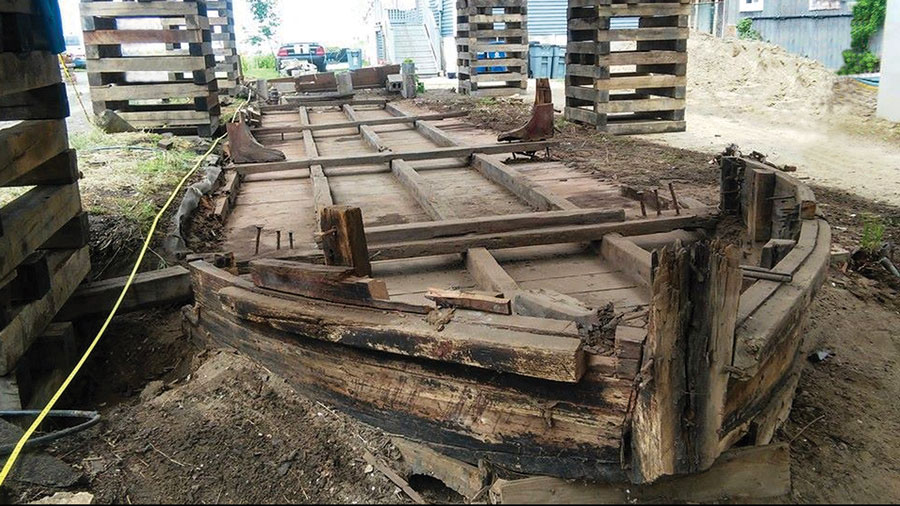
In 2012, another storm, the hurricane known as Sandy, wreaked such havoc and destruction along New Jersey’s shore that thousands of structures were later raised to prevent similar catastrophe from future storms. In the spring of 2016, as contractors worked to jack Eileen Scanlon’s Highlands home up onto raised piers, they were astonished to see what lay beneath. Eleven feet wide and nearly fifty feet long, a boat seemed to comprise much of the foundation and lower framework for the old house.
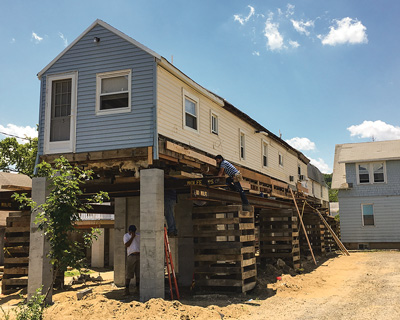
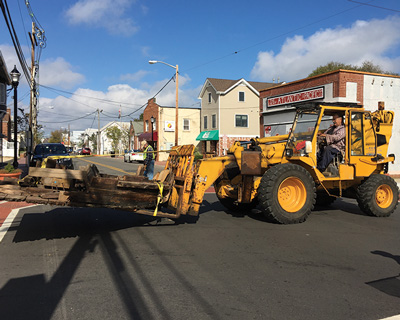
Ms. Scanlon stopped the work and notified the Highlands Historic Society. A local TV news reporter conjectured that the boat might have been employed to carry seafood, or even to run rum. And, as workers pulled pieces of the relic from the dirt, Ms. Scanlon said she’d like to use the bow as a garden decoration. Then, archaeologists who soon arrived to record the remains matched the boat’s measurements and manner of construction to that of a Morris Canal boat, something entirely alien to this part of New Jersey. When Joe Macesek, president of the Canal Society of New Jersey, arrived a few days later to confirm what the archaeologists suspected, he found the massive historic hulk fully removed from its resting place. “Since there was no way to remove the boat in one piece, the bow had been moved intact and the rest of the hull had been carefully cut into sections and stacked in the back yard of the property, the only space available,” remembers Macesek.
This was no small discovery! Of all the boats that were manufactured for service along the historic Morris Canal from 1831 to 1924, here was the sole known survivor. Although this was not a complete boat, here was a well-preserved section. An examination of the house, now perched twelve feet high on its new pillars, showed that the ribs of the boat had been adapted as part of the building’s construction. “You can’t make that up,” says Joe. “The gentleman probably acquired the boat from the Morris Canal basin in Jersey City and brought it here where it has remained for nearly a century.” Of all the thousands of vanished inland watercraft that once traversed the highlands of northern New Jersey, this one appears at Highlands by the sea!
In the fall of 2016, after Ms. Scanlon graciously agreed to donate the artifacts, the Canal Society began to plan for the last known Morris Canal boat’s future preservation and display for public edification. No place made more sense than the Waterloo Village Historic Site in Byram Township, the restored canal village that grew up approximately halfway along the Morris Canal’s 102-mile journey across the state, from Phillipsburg to Jersey City. Previously the site of a finery forge, Waterloo acquired all the components necessary for thriving canal commerce, and this orphan boat almost certainly saw time at the docks as her crew relaxed at the inn, resupplied at the general store and prepared their mules at the blacksmith shop for the journey’s next leg.
Today, Waterloo is owned and operated by the New Jersey Division of Parks and Forestry, an agency the Department of Environmental Protection and is part Allamuchy Mountain State Park. The Canal Society of New Jersey have for years maintained its Canal Museum at Waterloo and now partners with State Parks to brings the Village back to life. Starting in June with its annual Canal Day Festival then continuing through to summer into the fall, the CSNJ engages visitors with tours, live music, narrated canal boat rides, operating water-powered gristmill and historic trade at the blacksmith and carpenter shops.
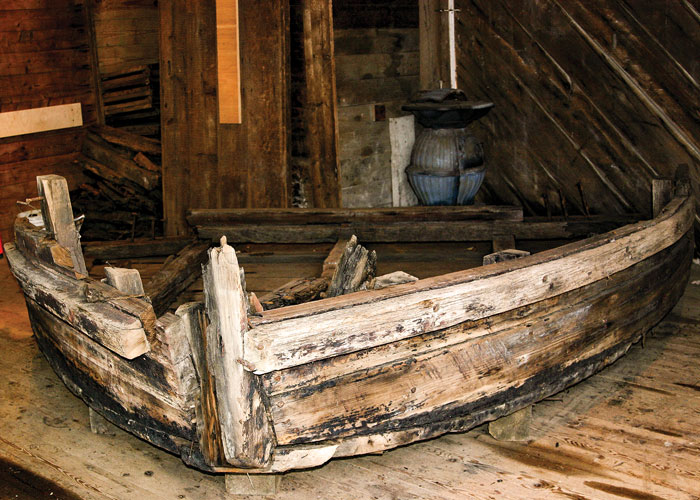
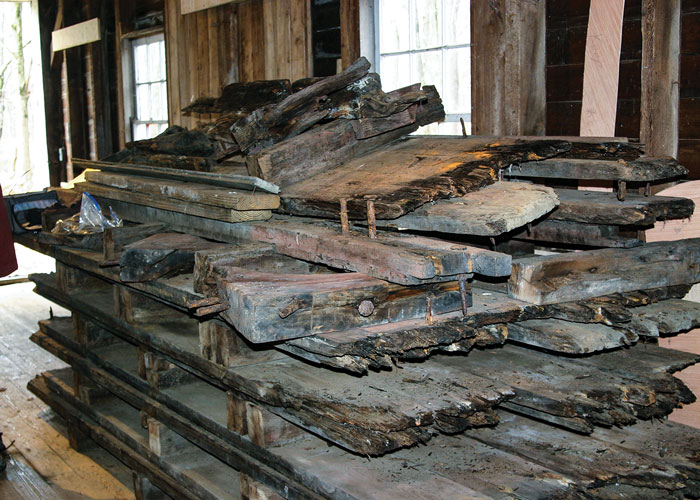
It was left to Canal Society volunteers to transfer the boat from Highlands to Waterloo, a happy but challenging task even for veterans well-versed in the logistics of accomplishing large-scale tasks on short notice with no budget. Having procured the donated use of the necessary equipment, the team began by transporting loads of historic fabric by forklift from the Scanlon property through narrow local streets to an enormous flatbed truck parked blocks away. Once back at Waterloo, the pieces were lifted from the truck and carried across the village to Samuel T. Smith’s Carriage House. All went well until it was time to admit the bow section, whose massive bulk and weight made it impossible to move through the cottage’s entrance. The bow was sawn in half, guided by a dozen men with block and tackle through the door, and then carefully reassembled inside.
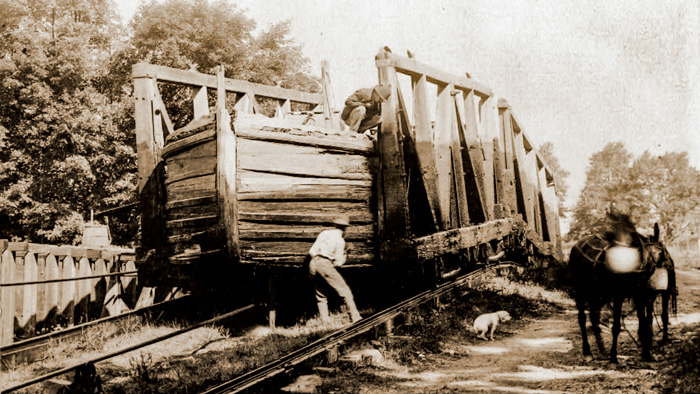
“A typical boat lasted only five to ten years,” explains Macesek. “To keep the canal in operation, the company, over the years, built thousands of boats to rigid specifications. This one could have been built any time between 1860s and the early 1900s.” Morris Canal boats were nearly ninety feet long and capable of carrying seventy tons of bulk cargo like coal from Pennsylvania—the canal’s lifeblood—along with other products such as building supplies, household perishables, and firewood. Constantly hauled in and out of the water, the boats were built in two sections hinged together to allow them flex when passing over the canal’s inclined planes, an innovation that allowed the boats to conquer an unprecedented 1,674-foot change in elevation along its route. The total length of this front section would have been forty-four feet; the living compartment for the captain and crew or family would have been in the rear.
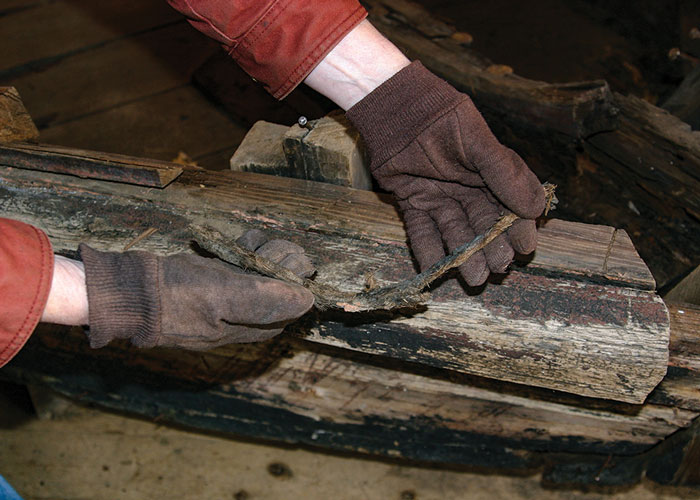
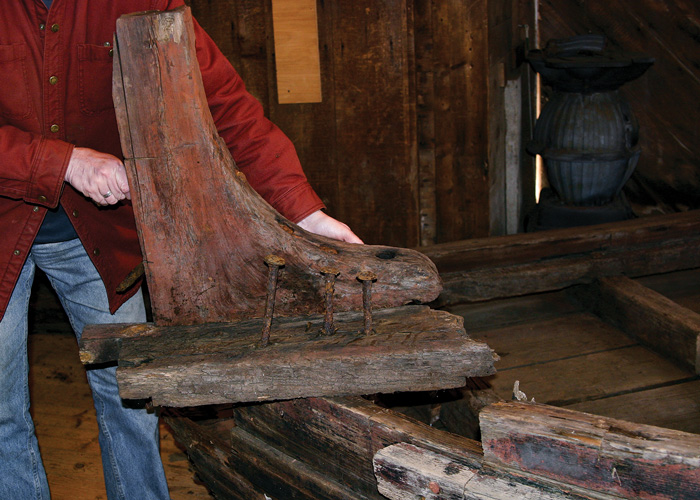
With access to historical schematic plans for canal boat construction, Macesek is confident that the Canal Society will be able to accurately interpret these recovered pieces. “The boats were six feet from deck to keel, and this gentleman seems to have cut it down to three, although the archaeologists couldn’t interfere with the building to see how much of the boat was actually there in the frame.” The part of the boat that came out from under the building is in remarkable condition. Although the metal spikes that held the boat together are corroded, the decking boards, made from southern yellow pine are solid excepting some rot at the ends. The planks were butted together, and the caulking fiber that was hammered between the joints to make the boat watertight is still there.
“It’s a whole different experience having a real boat to examine. It’s something to finally be able to match what I’ve seen in drawings with the real thing,” says Macesek. “It will be a challenge to make it come alive. But to its credit, everybody seems to get it. The boat is back home on the Morris Canal!”
The boat is on view for visitors at Waterloo Village throughout the season. Keep an eye on the Canal Society website for special events and exhibit news.